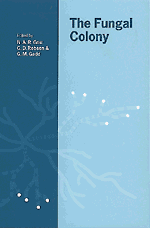Book contents
- Frontmatter
- Contents
- List of contributors
- Preface
- 1 Self-integration – an emerging concept from the fungal mycelium
- 2 Nutrient translocation and electrical signalling in mycelia
- 3 Colony development in nutritionally heterogeneous enviromnents
- 4 Circadian rhythms in filamentous fungi
- 5 Growth, branching and enzyme production by filamentous fungi in submerged culture
- 6 Metabolism and hyphal differentiation in large basidiomycete colonies
- 7 Role of phosphoinositides and inositol phosphates in the regulation of mycelial branching
- 8 Stress responses of fungal colonies towards toxic metals
- 9 Cellularization in Aspergillus nidulans
- 10 Genetic control of polarized growth and branching in filamentous fungi
- 11 Mating and sexual interactions in fungal mycelia
- 12 Genetic stability in fungal mycelia
- 13 Nuclear distribution and gene expression in the secondary mycelium of Schizophyllum commune
- Index
6 - Metabolism and hyphal differentiation in large basidiomycete colonies
Published online by Cambridge University Press: 22 January 2010
- Frontmatter
- Contents
- List of contributors
- Preface
- 1 Self-integration – an emerging concept from the fungal mycelium
- 2 Nutrient translocation and electrical signalling in mycelia
- 3 Colony development in nutritionally heterogeneous enviromnents
- 4 Circadian rhythms in filamentous fungi
- 5 Growth, branching and enzyme production by filamentous fungi in submerged culture
- 6 Metabolism and hyphal differentiation in large basidiomycete colonies
- 7 Role of phosphoinositides and inositol phosphates in the regulation of mycelial branching
- 8 Stress responses of fungal colonies towards toxic metals
- 9 Cellularization in Aspergillus nidulans
- 10 Genetic control of polarized growth and branching in filamentous fungi
- 11 Mating and sexual interactions in fungal mycelia
- 12 Genetic stability in fungal mycelia
- 13 Nuclear distribution and gene expression in the secondary mycelium of Schizophyllum commune
- Index
Summary
Introduction
Mycelial fungi are adapted for the colonization of solid surfaces (Carlile, 1994). These are unlike aquatic environments because natural mixing processes are insufficient for effective colonization of solid substrates. A common colonization and dispersal method, typical of the majority of ascomycetes (but by no means restricted to them) is the production of very large numbers of spores, allowing the faeile, but random, creation of new foci for mycelial exploitation of substrate. The disadvantage of this process is that the whole mycelium cannot be convened to spores when a particular mycelium has exhausted all the substrate in its range.
Within the basidiomycetes an alternative strategy has evolved, which is the formation of very large colonies that behave in a non-random manner with respect to colonization and, crucially, employ long-range translocation mechanisms to enable the re-use of scarce resources where new sub-strate is detected. This phenomenon is best described for some wood-degrading fungi of the forest floor and the dry-rot fungus Serpula lacrymans. In both cases wood substrate is dispersed in an otherwise nutrient-poor environment, requiring ‘foraging’. This is an unusual process in microorganisms (and in plants), where growth or movement towards detectable centres of nutrient is the common pattern. Again, the responses of the wood-degrading fungi have to be different in that their substrate is non-diffusing and cannot be detected chemotactically.
- Type
- Chapter
- Information
- The Fungal Colony , pp. 126 - 156Publisher: Cambridge University PressPrint publication year: 1999
- 1
- Cited by

